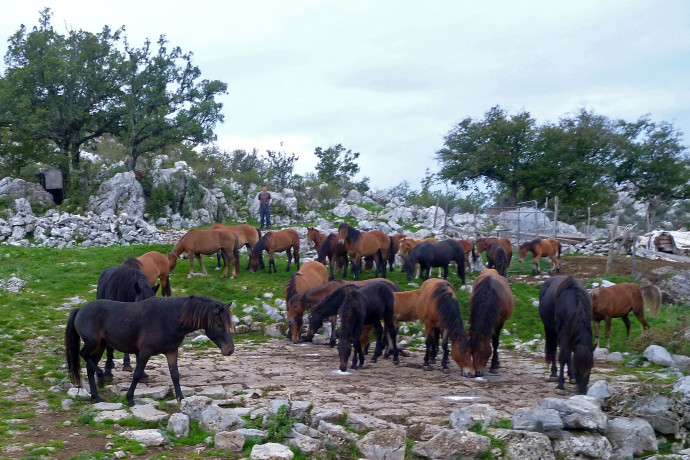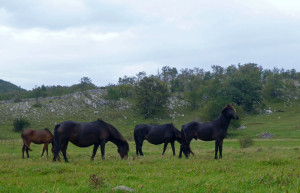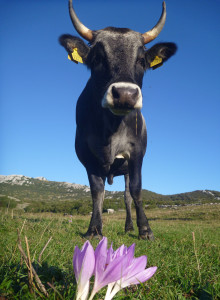On the morning of September 29, a horse transport was made in cooperation with the International Association of Bosnian Mountain Horse breeders, for release in Malo Libinje, at Petar Knežević’s farm in the Velebit rewilding area. I accompanied the truck carrying this first group of five new Bosnian mountain horses.

The breeders had selected this herd of two stallions and three mares from Gorski Kotar, Croatia. The Bosnian mountain horse is an ancient indigenous horse from the region of the former Yugoslavia. It is today an endangered breed with only around 200 individuals left. Rewilding Europe’s breeding and natural grazing programme in Velebit is at the same time a contribution to the preservation of this authentic horse.
The winding road up the mountain was pretty tough for the truck with the horses, so the transport took it nice and easy along the road. All the way up the mountain we had excellent views over the Adriatic coast and the mountain slopes and canyons. On the last part of the road to Petar Knežević’s farm we passed by the herd of about 20 mountain horses and the impressive and charismatic-looking Boškarin cows. When we arrived to the valley, the view there was even more spectacular.
On site, we decided to release the new horses in a small fenced area near the barn, to give them an opportunity to get used to their new environment and to recover from the somewhat bumpy trip. A bit disappointing for the photos, since I had hoped to take spectacular photos of horses jumping from the truck and running towards their freedom in the wilderness. But because of the recent predation from wolves on several horses in this area, this was right now more sensible to do. Since there had been so many horses lost horses to wolves Petar now every night gathered the horses from the valley to protect them in a corral near his farm.

After unloading the new horses we all had a nice meal that Petar had prepared. We discussed about the wolf predation and the concerns for the new horses. Although opinions differed, we all had in common that we wanted to give the best chance for the new horses. After some paperwork everybody left, except Petar and myself. What would I be doing now here over the next few days, at this beautiful but remote place? The next morning, I did some exploration in the valley and it was truly magnificent. The grey and black Boškarin cattle grazed in the green valley and completely melted into the background of surrounding rocks, what a great camouflage! The horses were grazing higher up the slopes, an image that repeated itself over the next couple of days. The little valley was full of life: lots of grasshoppers of various species were crawling in the vegetation, as well as big dung beetles, numerous butterflies, including Colias species and Issoria lathonia. There were also a lot of birds: you could find migratory birds in every bush, especially redstarts, robins, tits and thrushes. In the more open area’s, there were wheatears, stonechats, whinchats, larks and groups of wagtails. Later that day, Davor Krmpotic and Mei Elderadzi from the Rewilding Velebit team showed me some other beautiful places here, amongst them a waterhole a few kilometres further down the valley. Here we found fresh wolf tracks in the mud, including some young ones, indicating that a family of wolves had recently visited the place.
In the evenings I helped Petar to gather the horses for the night. The Boškarins had proved to be wolf-proof so far, so they stayed out also during the night.
Only the young calves were still inside Petar’s barn, until they are strong enough to join the herd.
We decided that we will let the new horses out of the fence the following day, in the hope the we could gather them again in the evening, together with the other horses. So in the evening, we merged the newcomers with the existing herd inside the fence, which resulted in some fighting between the old and the new stallion, but nothing very serious and all went quickly quiet that night.
Right after sunrise next morning, we first let out the oldest calf from the barn, which resulted in the sturdy little animal setting off in a series of happy jumps. The other herd members welcomed the calf into the herd, which was very nice to observe. If this calf would survive the next couple of days, the other calves will also be released. Look at it on:
After that we released the horses, which after eating some salt walked away straight into the valley. The new group immediately started grazing the lush green grass, for they hadn’t seen fresh grass for two days. The stallion from the old group did some attempts to herd the new group into his, but the new mares didn’t agree. The new group remained in the valley all day, accompanied by the Boškarin cows. The other group of horses disappeared from view somewhere in the hill side, where they would graze all day, in lee from the fierce Bura winds that were blowing.
Later in the day I was surprised by the determination by one of the mares of the new group: she walked straight from the valley to Petar’s farm, followed by the rest of the group. They were looking for water, and walked into the shed where there was water inside. After they all had a drink they then returned again to the valley to graze. Amazing how quick they learn!

The next challenge was to gather all the horses for the night, and herd them into the corral at Petar’s farm. This went quite well, although we had to run a few times to herd the two groups in the same direction. We were now with two men, but from the next day onwards, Petar has to manage this on his own. Hopefully, it will work. However I have full confidence in Petar, because he knows the horses and the mountains like no other and his heart is really truly with the animals. The situation with the local wolves in Malo Libinje that seemingly have specialised on horses, is now quite unique in Europe and it will be a challenge to find the right way to rewild many horses enough and having them all learn to live and survive in the wild, but on the other hand, it has been done by millions of horses and for thousands of years before, so it will most likely work here as well.
The next morning, we let out the horses and also discovered that the big and sturdy calf survived her first night in the wilderness. Unfortunately, it was time for me to leave Malo Libinje, but I’m sure it will not be my last visit to this beautiful place.
